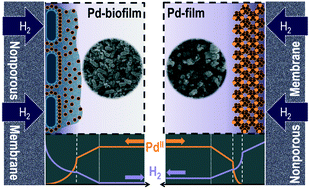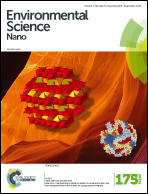Biofilm-enhanced continuous synthesis and stabilization of palladium nanoparticles (PdNPs)†
Abstract
Biosynthesis of palladium nanoparticles (PdNPs) is considered an efficient and green method for catalytic applications. Reported short-term batch studies have demonstrated PdNP synthesis using suspended biomass, but the PdNPs tended to agglomerate to large sizes and be washed out along with the biomass under continuous operation. Biofilm is a promising alternative for continuous PdNP synthesis, as it contains significant extracellular polymeric substances (EPS) with functional groups able to adsorb/stabilize PdNPs, and the biofilm and its PdNPs are naturally retained. We tested continuous Pd nanoparticle (PdNP) synthesis using a denitrifying biofilm that promoted enzymatic and autocatalytic reduction of PdII to Pd0 on the surface of non-porous hollow-fiber membranes that delivered hydrogen gas (H2) as the electron donor. The biofilm retained >99% of PdNPs. Approximately one-half were bound as 20 to 100 nm grains on the cell surfaces, while the other half were dispersed as 3 to 4 nm Pd0 crystallites within the extracellular polymeric substance (EPS) matrix. When no biofilm was present, PdII was reduced autocatalytically to Pd0, which self-assembled to form larger aggregates in a continuous, yet fragile film on the membrane. As a result, the stabilized PdNP-biofilm catalyzed further the PdII reduction faster than the agglomerated Pd-film. These results document the beneficial roles of biofilm in enhancing PdNP production, and provide a baseline for practical long-term sustainable Pd recovery from waste streams using biofilm systems.



 Please wait while we load your content...
Please wait while we load your content...